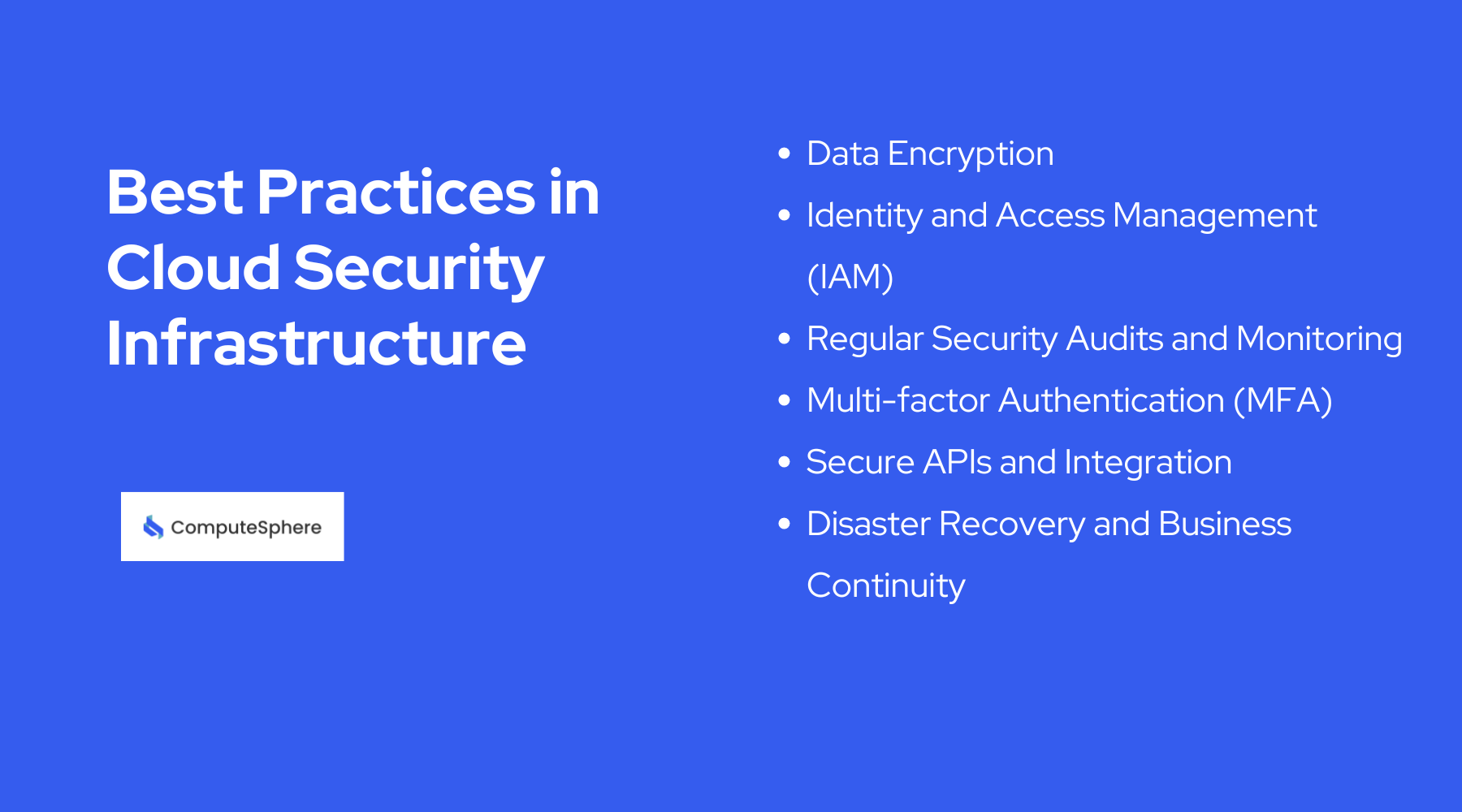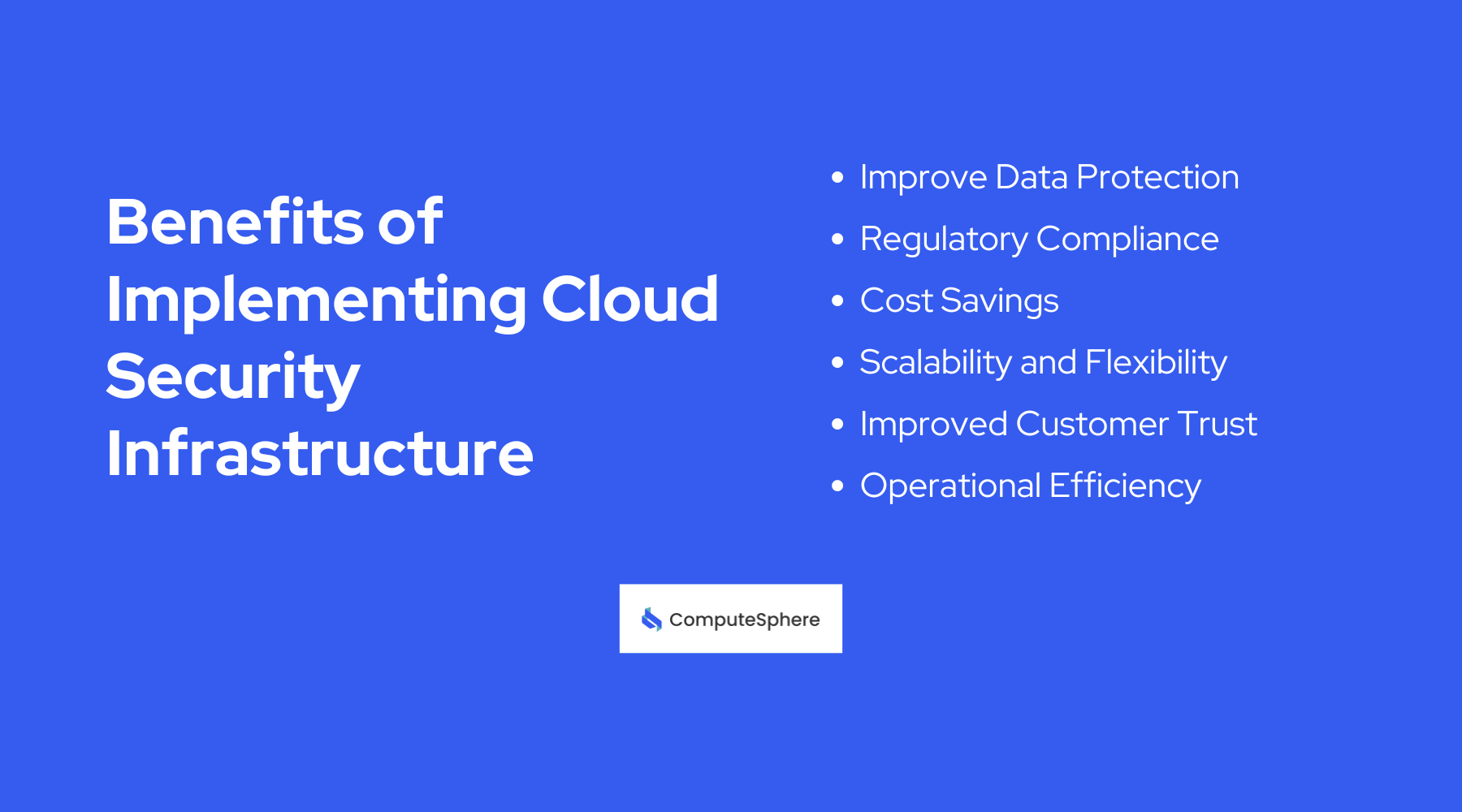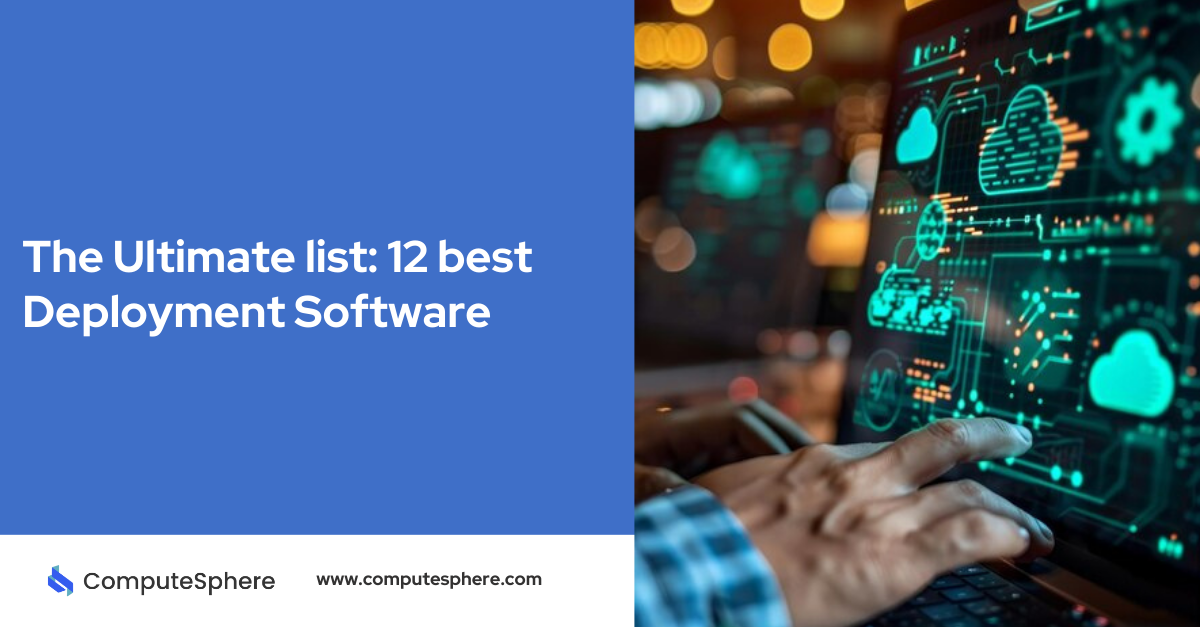Cloud Security Infrastructure: 6 Best Practices & Benefits

Cloud security infrastructure ensures strong protection for data and applications in cloud environments. By prioritizing practices like encryption, IAM, regular audits, MFA, secure APIs, and disaster recovery planning, organizations strengthen their defenses against cyber threats. These measures not only reduce risks but also improve operational durability, regulatory compliance, and customer trust. It establishes a secure foundation for digital transformation and sustainable growth.
This article covers six essential practices in cloud security infrastructure and emphasizes their significant advantages for businesses.
Best Practices in CloudSecurity Infrastructure

Data Encryption
One of the foundational pillars of cloud security is data encryption, which involves encoding information in such a way that only authorized parties can access it. Encryption ensures that even if data is captured, it remains unreadable without the corresponding decryption keys. Organizations should prioritize encrypting data both at rest (stored data) and in transit (data being transferred between users and cloud servers).
Implementing strong encryption protocols, such as Advanced Encryption Standard (AES) and Transport Layer Security (TLS), adds a layer of protection against potential breaches. This practice not only safeguards sensitive information but also helps organizations comply with regulatory requirements concerning data privacy and protection.
Identity and Access Management (IAM)
Identity and Access Management (IAM) is essential for maintaining control over who can access what within a cloud environment. Adopting a role-based access control (RBAC) framework allows organizations to define and enforce permissions based on users' roles and responsibilities. By assigning least privilege access, where users only have access to the resources necessary for their tasks, organizations can minimize the risk of insider threats and unauthorized access.
In addition, IAM systems also facilitate centralized management of user identities, enabling quick assignment and revocation of access rights as employees join, move within, or leave the organization. This practice strengthens security posture by ensuring that only authenticated and authorized users can interact with sensitive data and applications.
Regular Security Audits and Monitoring
Continuous monitoring and regular security audits are critical components of proactive cloud security management. Monitoring tools provide real-time visibility into cloud environments, detecting anomalies or suspicious activities that may indicate a potential security breach. By analyzing logs and monitoring metrics, organizations can promptly respond to security incidents and mitigate risks before they escalate.
Additionally, conducting periodic security audits helps evaluate the effectiveness of existing security measures and identifies vulnerabilities that need addressing. Audits also assist in ensuring compliance with industry standards and regulations, demonstrating to stakeholders a commitment to maintaining robust security practices.
Multi-factor Authentication (MFA)
Multi-factor Authentication (MFA) adds an extra layer of security by requiring users to verify their identity using multiple factors before gaining access to cloud resources. Typically, MFA combines something the user knows (e.g., password or PIN) with something they have (e.g., smartphone app or token) or something they are (e.g., biometric data like fingerprint or facial recognition).
Implementing MFA reduces the risk of unauthorized access, even if credentials are compromised. It improves authentication security by ensuring that accessing sensitive data or applications requires more than just a password. This prevents potential cyberattacks such as email scams and credential stuffing.
Secure APIs and Integration
As organizations increasingly rely on cloud-based APIs (Application Programming Interfaces) to integrate disparate systems and services, securing these APIs becomes crucial. Insecure APIs can expose sensitive data and functionalities to unauthorized third parties, leading to data breaches and service disruptions.
Adopting best practices for API security, such as authentication, authorization, and encryption of data transmitted via APIs, helps reduce risks associated with API vulnerabilities. Organizations should also regularly update and patch APIs to address newly discovered security flaws and vulnerabilities. It ensures strong protection against evolving cyber threats.
Disaster Recovery and Business Continuity
Disaster recovery and business continuity planning are integral to maintaining operational resilience in the face of potential security incidents or natural disasters. Cloud environments offer scalable and cost-effective solutions for backing up data and applications, reducing the impact of downtime on business operations.
By implementing comprehensive disaster recovery plans, organizations can quickly recover data and restore services in the event of a cyberattack, hardware failure, or other disruptive incidents. Cloud-based disaster recovery solutions also facilitate regular testing and validation of recovery procedures, ensuring readiness to respond effectively to unexpected emergencies.
Benefits of Implementing Cloud Security Infrastructure

Improve Data Protection
Implementing strong cloud security infrastructure improves data protection by safeguarding sensitive information against unauthorized access and data breaches. Encryption, IAM controls, and secure APIs collectively contribute to creating a secure environment where data confidentiality and integrity are preserved.
Regulatory Compliance
Adhering to regulatory requirements such as GDPR, HIPAA, and PCI DSS is crucial for organizations operating in highly regulated industries. By implementing best practices in cloud security infrastructure, organizations can demonstrate compliance with data protection regulations and avoid potential penalties or legal consequences.
Cost Savings
Effective cloud security infrastructure reduces the financial impact of security incidents and data breaches. By investing in proactive security measures, organizations can reduce the risk of costly remediation efforts, reputational damage, and potential loss of business due to service interruptions or data loss.
Scalability and Flexibility
Cloud-based security solutions offer scalability and flexibility, allowing organizations to adapt their security measures in response to changing business needs and evolving cyber threats. Cloud environments enable seamless integration of new security technologies and services without the need for significant advance investments in hardware or infrastructure.
Improved Customer Trust
Strong cloud security infrastructure improves customer trust and loyalty by demonstrating a commitment to protecting their sensitive information. Customers are more likely to engage with organizations that prioritize data privacy and security, building long-term relationships based on transparency and accountability.
Operational Efficiency
Streamlining security management processes through automation and centralized controls improves operational efficiency. Cloud-native security solutions provide real-time insights and analytics. It enables proactive threat detection and rapid response to security incidents, thereby minimizing service interruption and optimizing resource utilization.
Conclusion
Implementing best practices in cloud security infrastructure is essential for safeguarding organizational assets and maintaining trust in an increasingly digital world. By prioritizing data encryption, IAM controls, regular security audits, MFA, secure APIs, and disaster recovery planning, organizations can improve data protection, achieve regulatory compliance, and realize significant cost savings.
Moreover, adopting cloud security infrastructure not only reduces risks but also empowers organizations to utilize cloud technologies securely, supporting business growth and robustness against evolving cyber threats.
Contents
Built for Builders. Priced for Startups.
Tired of unpredictable cloud bills? ComputeSphere offers modular, fixed-cost cloud hosting that grows with your startup—no DevOps headaches, no surprises.
Get StartedShare this article
Browse Some Related Blogs
Relevant and related contents you can read









